A) A
B) B
C) C
D) D
E) E
Correct Answer

verified
Correct Answer
verified
Short Answer
A ________ group does not contain the most recent common ancestor.
Correct Answer

verified
Correct Answer
verified
Short Answer
The behavior of parental care exhibited by dinosaurs is thought to be ________ to this behavior in crocodiles and birds because phylogeny shows that these three groups share a common ancestor.
Correct Answer

verified
Correct Answer
verified
Multiple Choice
 -The table shows the distribution of traits (A-E) in six extant species (1-6) .A "0" indicates the ancestral condition,while a "1" indicates the derived condition.Which trait is represented by the greatest number of plesiomorphies?
-The table shows the distribution of traits (A-E) in six extant species (1-6) .A "0" indicates the ancestral condition,while a "1" indicates the derived condition.Which trait is represented by the greatest number of plesiomorphies?
A) A
B) B
C) C
D) D
E) E
Correct Answer

verified
Correct Answer
verified
Multiple Choice
The evolution of conducting tubes (sieve tubes) in land plants and brown algae is an example of
A) homoplasy caused by convergence.
B) homoplasy caused by common descent.
C) homoplasy caused by evolutionary reversal.
D) homology caused by convergence.
E) homology caused by common descent.
Correct Answer

verified
Correct Answer
verified
Multiple Choice
 -The table shows the distribution of traits (A-E) in six extant species (1-6) .A "0" indicates the ancestral condition,while a "1" indicates the derived condition.Based on this data,which pair of species diverged most recently?
-The table shows the distribution of traits (A-E) in six extant species (1-6) .A "0" indicates the ancestral condition,while a "1" indicates the derived condition.Based on this data,which pair of species diverged most recently?
A) 1 and 4
B) 2 and 3
C) 2 and 4
D) 6 and 4
E) 6 and 5
Correct Answer

verified
Correct Answer
verified
Multiple Choice
Select all of the following that can result in homoplasies.
A) convergent evolution
B) evolutionary reversals
C) divergent evolution
D) shared ancestry
Correct Answer

verified
Correct Answer
verified
Multiple Choice
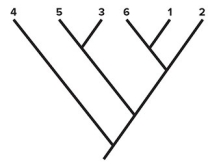 -Consider the cladogram shown.Based on this cladogram,which species has the greatest number of ancestral character states?
-Consider the cladogram shown.Based on this cladogram,which species has the greatest number of ancestral character states?
A) 1
B) 2
C) 3
D) 4
E) 5
Correct Answer

verified
Correct Answer
verified
Multiple Choice
 -The table shows the distribution of traits (A-E) in six extant species (1-6) .A "0" indicates the ancestral condition,and a "1" indicates the derived condition.Which pair of species shares the greatest number of derived characters (synapomorphies) ?
-The table shows the distribution of traits (A-E) in six extant species (1-6) .A "0" indicates the ancestral condition,and a "1" indicates the derived condition.Which pair of species shares the greatest number of derived characters (synapomorphies) ?
A) 1 and 4
B) 6 and 3
C) 6 and 1
D) 5 and 6
E) 5 and 1
Correct Answer

verified
Correct Answer
verified
Multiple Choice
Choose the true statements about molecular clocks.
A) All molecular clocks tick at the same rate.
B) Molecular clocks can be calibrated using fossil evidence.
C) The rate of a molecular clock for a given DNA character might vary depending on how constrained the character is by natural selection.
D) Ultimately,all molecular clocks depend on the rate of DNA mutation and DNA repair mechanisms.
Correct Answer

verified
Correct Answer
verified
Multiple Choice
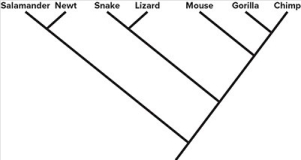 -Based on the phylogeny shown,choose the true statements about evolutionary relationships (Select all that apply) .
-Based on the phylogeny shown,choose the true statements about evolutionary relationships (Select all that apply) .
A) A snake is more closely related to a newt than to a mouse.
B) A newt is equally related to a snake and a chimp.
C) A mouse is more closely related to a chimp than to a snake.
D) A salamander is more closely related to a mouse than to a chimp.
Correct Answer

verified
Correct Answer
verified
Multiple Choice
The figure shows the evolutionary diversification of the largest clade of herbivorous beetles with the group of plants on which they specialize.Choose the true statements about the evolution of species richness in herbivorous beetles. 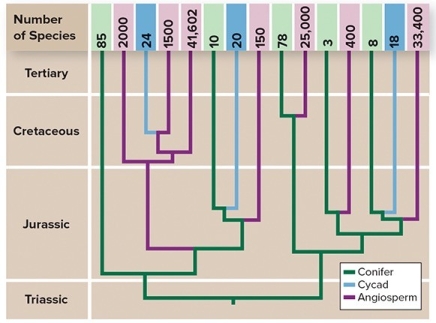
A) Feeding on conifers evolved earlier than feeding on angiosperms.
B) Feeding on cycads evolved earlier than feeding on angiosperms.
C) Diversification of the angiosperms may have led to diversification of herbivorous beetles.
D) The multiple,independent evolution of herbivory in beetles is closely linked to their great species richness.
Correct Answer

verified
Correct Answer
verified
Short Answer
A ________ group consists of the most recent common ancestor and all of its descendants.
Correct Answer

verified
Correct Answer
verified
Multiple Choice
 -The table shows the distribution of traits (A-E) in six extant species (1-6) .A "0" indicates the ancestral condition,and a "1" indicates the derived condition.Which pair of species shares the fewest number of derived characters (synapomorphies) ?
-The table shows the distribution of traits (A-E) in six extant species (1-6) .A "0" indicates the ancestral condition,and a "1" indicates the derived condition.Which pair of species shares the fewest number of derived characters (synapomorphies) ?
A) 1 and 6
B) 1 and 4
C) 4 and 6
D) 2 and 3
E) 6 and 3
Correct Answer

verified
Correct Answer
verified
Multiple Choice
 -The table shows the distribution of traits (A-E) in six extant species (1-6) .A "0" indicates the ancestral condition,and a "1" indicates the derived condition.Which trait is least informative of phylogenetic relationships within the group?
-The table shows the distribution of traits (A-E) in six extant species (1-6) .A "0" indicates the ancestral condition,and a "1" indicates the derived condition.Which trait is least informative of phylogenetic relationships within the group?
A) A
B) B
C) C
D) D
E) E
Correct Answer

verified
Correct Answer
verified
Multiple Choice
The figure shows a cladogram of direct development versus development of a larval stage.Choose the true statements about the evolution of development in limpets. 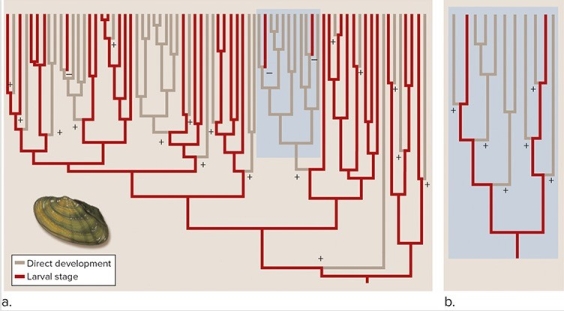
A) Loss of structures in the transition from a larval stage to direct development prohibits evolutionary reversal.
B) Direct development has evolved multiple times.
C) Evolution always proceeds parsimoniously.
D) Possession of a larval stage is the ancestral state in limpets.
Correct Answer

verified
Correct Answer
verified
Multiple Choice
Choose the true statements about the evolution of complex characters,such as powered flight.
A) Phylogenetic analysis using cladistics can help reveal the sequence leading to the evolution of a complex character.
B) Usually a single mutation in one gene leads to the simultaneous appearance of the complex character.
C) Often the initial stage in the evolution of a complex character was an adaptation to some unrelated selection pressure.
D) The intermediate stages in the evolution of a complex character had no fitness advantage.
Correct Answer

verified
Correct Answer
verified
Multiple Choice
Choose the true statement about the morphological data in the chart shown below.The "1" in the box means the trait is present and the "0" indicates that the trait is absent.(Note: All of the characteristics across the top of the columns are considered "TRAITS" for purposes of reading the chart.) . 
A) All organisms in this chart share all of the derived characteristics.
B) Only the gorilla and humans share all of the derived characteristics.
C) The lamprey is the only outgroup since it has none of the derived characteristics.
D) The salamander and the tiger together are the outgroup because they only share two of the derived characteristics (jaws and lungs) .
E) The shark is the outgroup since it only has one of the derived characteristics (jaws) .
Correct Answer

verified
Correct Answer
verified
Short Answer
The biological specialty that deals with the reconstruction and study of phylogenies is called ________.
Correct Answer

verified
Correct Answer
verified
Multiple Choice
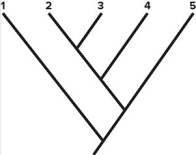 -Based on the phylogeny shown,we can conclude that species 2 is most closely related to species
-Based on the phylogeny shown,we can conclude that species 2 is most closely related to species
A) 1.
B) 3.
C) 4.
D) 5.
E) 1 or 3 (can't tell) .
Correct Answer

verified
Correct Answer
verified
Showing 21 - 40 of 67
Related Exams